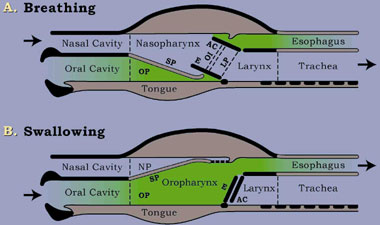Synthetic Windpipe
 Polymers
are already used in medical devices, but the properties of these novel polymers
reduce the risk of rejection, rupture, or the need for repeat surgery. They have
better elasticity, strength and versatility and are formulated to encourage cell
growth. Polymers
are already used in medical devices, but the properties of these novel polymers
reduce the risk of rejection, rupture, or the need for repeat surgery. They have
better elasticity, strength and versatility and are formulated to encourage cell
growth.
A University College London, UK, scientist and his
team designed and built the synthetic windpipe ‘scaffold’ used in an operation
in Sweden announced by the Karolinska University Hospital and Karolinska
Institute.
The windpipe (trachea) implanted in this patient was
developed using Nanocomposite materials which were developed and patented by
Professor Alexander Seifalian (UCL Division of Surgery & Interventional
Science), whose labs are based at the Royal Free Hospital. Together with
Professor Paolo Macchiarini at Karolinska, who also holds an Honorary
appointment at UCL, Professor Seifalian designed and developed the trachea
scaffold using a material known as a novel Nanocomposite polymer.
Professor Seifalian has worked closely with UCL
Business (UCLB), responsible for technology development and commercial
transactions at UCL, to patent these materials and develop their use in medical
devices. As well as being used for tissue scaffolds, the materials have other
potential uses such as coronary stents and grafts.
A Nanocomposite is a material containing some
components that are less than 100 nanometers (nm) in size. To give a sense of
scale, a human hair is about 60,000 nanometers in thickness. A polymer is a
repeating chain of small, identical molecules (called monomers) which are linked
together.

Surgeons in Sweden have carried out the world’s
first synthetic organ transplant using a windpipe ‘grown’ from the patient’s
stem cells. The replica organ was designed and developed by EPSRC sponsored
Scientists.
The surgeons successfully implanted a synthetic
windpipe ‘scaffold’ into the throat of a cancer patient. Without the new
windpipe (trachea), the patient, whose own windpipe had been blocked by an
inoperable tumor the size of a golf ball, would have died.
The team used 3D computerized tomography (CT) scans
of the patient to craft a perfect copy of his trachea using a glass mould, from
which they developed a replica ‘scaffold’ using a novel Nanocomposite Polymers.
The full size Y shaped replica was taken to
Karolinska University Hospital in Sweden where stem cells taken from the
patient’s bone marrow and linings from his nose were incorporated to it (or
‘seeded’) by Professor Paolo Macchiarini, who codeveloped the scaffold with
Professor Seifalian and also performed the surgery. After two days, the millions
of nanoscale holes in the porous windpipe had been seeded with the patient’s own
tissue.
The full Biological trachea was grow in a bioreactor
a device designed for the procedure which provides the correct environment for
the tissue to grow, and very effectively simulates the growth of natural tissue.
The result a synthetic windpipe with the same properties as a ‘real’ trachea.
The 12-hour operation was a complete success. In
this transplantation the tracheas used were taken from organ donors and then
reseeded with the patient’s own stem cells.
Surgeons in Sweden have carried out the world’s
first synthetic organ transplant using a windpipe ‘grown’ from the patient’s
stem cells. The replica organ was designed and developed by EPSRC sponsored
scientists.
“What makes this procedure different is it’s the
first time a wholly tissue-engineered synthetic windpipe has been made and
successfully transplanted, making it an important milestone for regenerative
medicine”. |